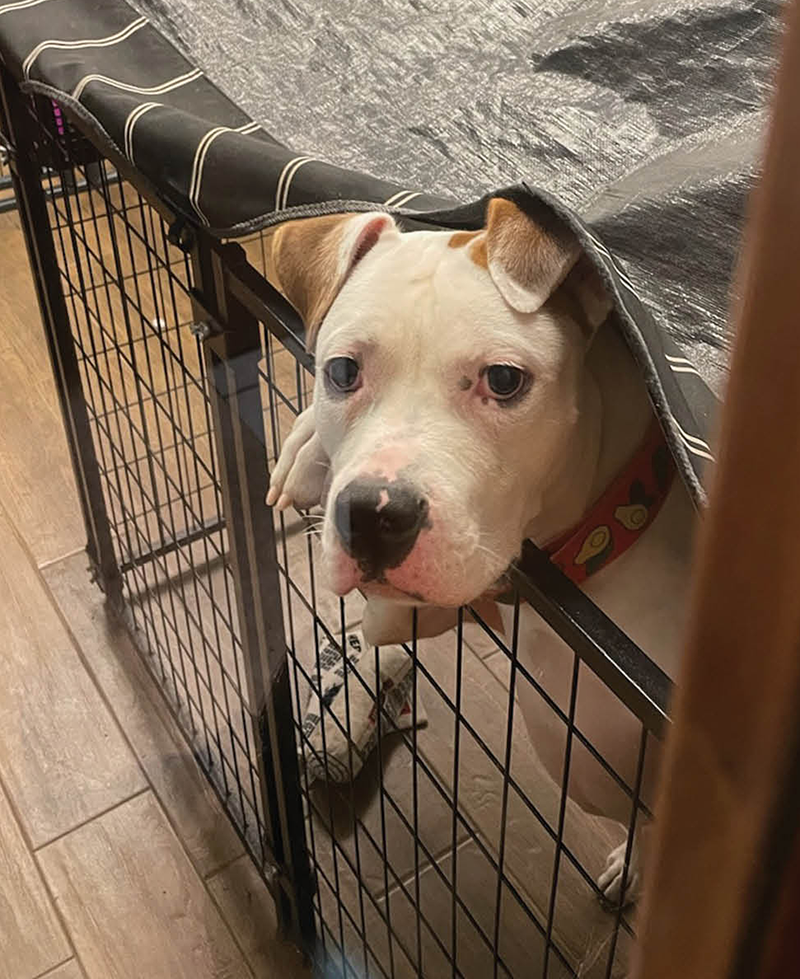By Rebecca Maglischo
Photos Courtesy of Polk County Bully Project
After a month of following the Polk County Bully Project (PCBP) on social media, I pull up in the parking lot. I’m a bundle of emotions four weeks out from the tragic loss of my own four-legged bestie, and my skepticism meter is off the charts. Forty years growing up in Polk County plus thousands of miles training for marathons on these streets has taught me to stay alert for stray dogs and to regard anything that might resemble a pitbull with due caution. As I gather my notebook and pen, I wonder to myself why exactly I feel this way. While I’ve had plenty of run-ins with strays, I’ve never actually had an incident with a bully breed; it’s just something I “know,” feed store chatter, something whispered. The building is nothing more than a converted office building with a shaded and fenced outdoor area filled with dog toys and kiddie pools. Volunteers and employees are in and out of the front door with various dogs on leashes and clear protocols for such a simple day-to-day task. The fenced area is hosting a doggie play time—3 black dogs of varying ages and sizes are frollicking in the water spray of a hose while a volunteer praises them.


This is the main hub for the Polk County Bully project, a small charity with a seemingly insurmountable goal—Save The Bullies! While many animal control agencies are on track to become no-kill shelters, Polk County has a dire animal control situation. Intake rates at Polk County Animal Control are so high that a moratorium was placed on owner surrenders because the facility maintains a maximum capacity with just the dogs that are picked up by officers. The largest percentage of the dogs in the shelter is composed of bully breeds—pitbull and bulldog varieties, or any mix that might be perceived as one. An animal labeled as a pitbull cannot be adopted out, except to an approved 501c3 rescue. Without a rescue literally coming to the rescue, these dogs simply do their time and add to the euthanization statistics. Animal Control workers try hard to move animals out and into rescues.
The animal welfare issues in Polk County are complex and long-standing. “Here’s how it works,” Shannon explains. “Polk County is one of the fastest growing counties in the nation. When the population of people goes up, so does the animal population… and so does the number of puppies. Socio-economic issues create a cycle where the pups can’t be properly cared for, and neither can the mature dogs be spayed and neutered. It’s a mess!”
Angela chimes in. “Only about 7% of the dogs we pull have been spayed or neutered. Many of the females are pregnant. One month, we took in eight pregnant females that gave birth to 72 puppies. That is the rate of the problem.”
Angela and Shannon insist “things do not have to be this way.” In many counties legislation has been implemented with excellent results. Hillsborough County, for example, currently requires owners to register and license their cats and dogs and breeders to obtain permits. They also provide rebate incentives for spaying and neutering. In 2000, before the spay/neuter program, 23,827 dogs and cats were euthanized.
In 2020, the number was in the hundreds. Volusia County took in over 15,000 dogs and cats in 2007. By 2021, the intake was just under 1000 animals. Orange, Manatee, Hardee, Pinellas, Lake, Pasco, Volusia—the list of counties with rebate or incentive programs for spay and neuter is long. Polk County is being encouraged by rescue organizations and residents alike to carry this positive trend forward.
Polk County Bully Project has amassed a huge following with their adorable social media feed and frequent opportunities for citizens to “Meet the Bullies.” With a wide net of foster homes, volunteers, and doggy date chaperones, these ladies are pulling it off. But there is never enough money, supplies, foster homes, or families ready to adopt. While the focus is on Bully breeds—pitbull and bulldog varieties—PCBP is known to pull any dog, they can house, regardless of breed. Weekly visits to Animal Control allow them to keep tabs on dogs they wish to rescue until space opens or a foster volunteer comes forward.
Shannon says, “We try to put our hands on as many dogs as we can, and taking them into a foster home greatly improves their situation. They can practice manners, learn how to live the lush life, and get the veterinary care they need, as well as decompress from what was likely a very stressful time.”
Humans and dogs have walked side by side for at least 12,000 years. That’s a good run, a symbiosis that serves both species. Man’s Best Friend, with that sloppy tongue and waggly tail, needs us as much as we need them. And in Polk County, the four-legged need the two-legged to intervene. Adoption is the hope that anchors every rescue organization. Perfectly “adopt a-bull” sweethearts are waiting for the love and comfort of a fur-ever family! If one of those families is yours, please reach out to the Polk County Bully Project or a pit bull rescue near you.
Look for the Polk County Bully Project!
– www.polkcountybullyproject.org @PolkCountyBullyProject – Puppies on the Patio at Greenwise Publix in Lakeland
– Pitbulls and Pints at the Yard on Mass in Lakeland
– Pet Sense in Highland City
– “Dog Days” at Friday Fest in Bartow – Brewhub Night Market in Lakeland










